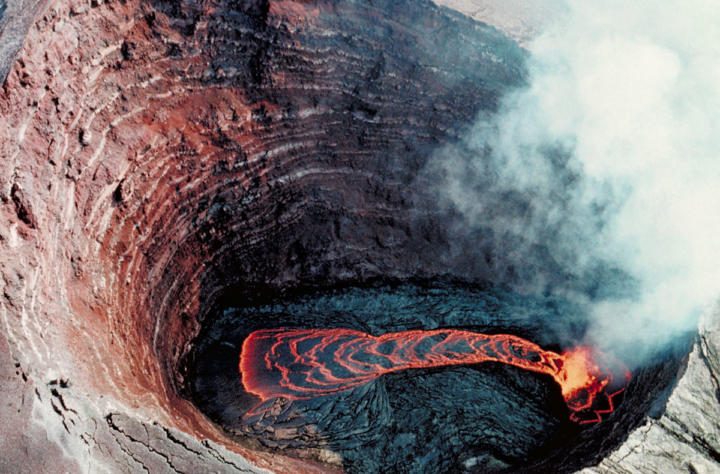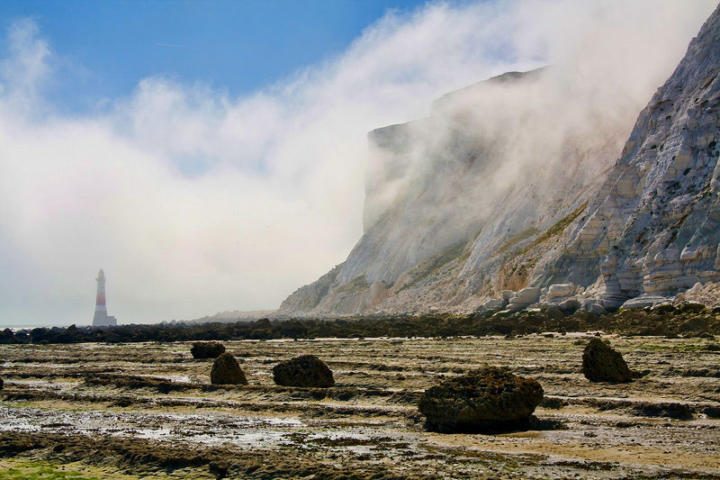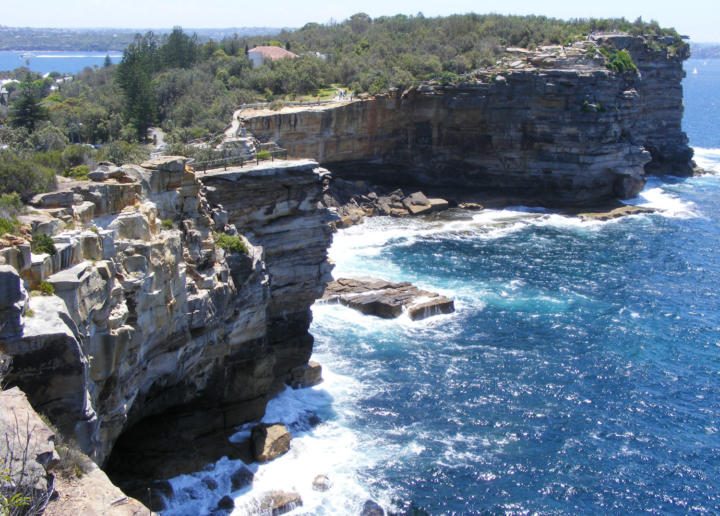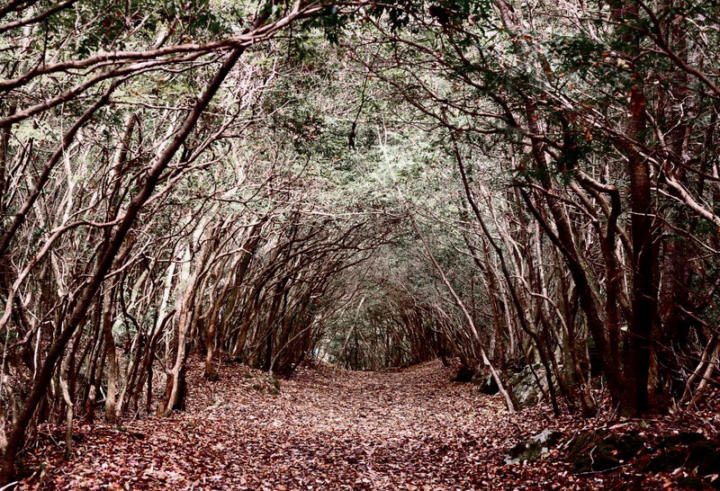Each year somewhere in the region of a million people take their own life. The only consolation to this tragic figure is that the vast majority who attempt suicide do not succeed.
Statistically the number of deaths at these locations is fairly miniscule compared to the overall figure. Nearly all the suicide spots below involve jumping from a height, whereas the most common methods are hanging, pesticide poisoning or shooting. Most of the spots listed below are as deadly as they are dramatic with only one having a survival rate higher than a few percent.
Why people are drawn to these so-called popular suicide spots is the subject of some debate but it appears to be a different type of suicide to those who simply take a bottle full of pills and go to bed. The suicides at the locations below can sometimes be seen as a final statement and will often draw more attention.
10. Mount Mihara, Japan

We’ll start of the list with the nation best known for its suicidal tendencies, Japan.
Mount Mihara is an active volcano situated on the small island of Izu Ōshima around 100 km (60 miles) south of Tokyo. The island and in particular Mt Mihara feature prominently in Japanese culture; the volcano was where Godzilla was entombed by the Japanese government in “The Return of Godzilla“. It also features in the 1998 movie, “Ring” where the main character’s mother throws herself into the crater.
Whilst that was fiction it is based on the macabre history of Mount Mihara. Dubbed “Suicide Island” Izu Ōshima became the final destination of choice for despondent lovers. It is said that what went on to become an epidemic of suicides was begun by a 21-year old student, Kiyoko Matsumoto. She threw herself into the fiery crater as she couldn’t bear not being able to be with the love of her life, another female student.
That year Mt Mihara became the suicide spot of choice with some citing a figure of over 900 people throwing themselves into the volcano. Such was the popularity that the Tokyo Bay Steamship Company laid on extra ferries.
In the following years the suicides continued, although not quite at the same rate. The volcano was the place to commit shinjuu – a mutual suicide pact between lovers.
The authorities finally stepped in to end the suicides at Mt Mihara by increasing security and preventing people from buying one-way tickets to the island. Or so the story goes…
9. Bosphorus Bridge, Istanbul, Turkey

Also known as the First Bridge this 1 miles (1.6km) long bridge joins the two continents of Asia and Europe. The suspension bridge rises 210ft (64m) above the waters Bosphorus Strait below. As such it is a fairly effective suicide spot although there is still no guarantee – one study calculated that there is statistically a 3% chance of surviving the fall.
The bridge was opened in 1973 to much fanfare although it wasn’t long before the first suicides. In an effort to stop these the authorities made it illegal for people to access or cross the bridge by foot. It seems that this didn’t resolve the problem as since then the majority of jumpers arrived at the bridge by taxi. I can only imagine they asked to be dropped off halfway across the bridge, whether they paid their final fare or not is another question.
Figures on how many people have killed themselves jumping from this bridge are hard to come by although they certainly number in the hundreds.
8. New York Skyline

If there is one thing New York City is famous for it is very tall buildings. Nowhere in the world is there quite such a concentration of skyscrapers and many have been there for the best part of a century now.
It seems that this point has not been lost on NYC’s residents who want to end it all. Compared to other U.S. cities the percentage of deaths by jumping is much higher here, around 10 times higher in fact. Committing suicide by jumping from a height is actually one of the most common methods in New York accounting for nearly 20% of all suicides. In the 30 years up until 2008 over 5,000 people threw themselves off the tall buildings and bridges of New York City.
There is one simple explanation for why the rate of jumping is so high; basically a person with suicidal intentions is going to use whatever means are available to them at the time. Ergo, if you are surrounded by some of the world’s tallest structures.
Of all the spots to jump from in the city it is probably the Empire State Building that has gained the greatest notoriety. Standing at over 1000ft (300m) tall the 86th floor observation deck is not completely closed in like those of most modern skyscrapers. That said there is a high fence designed precisely to prevent people from leaping. However, over the years nearly 40 people have leapt to their deaths from the Empire State Building.
The good news though is that New York has around half the national average suicide rate.
7. Beachy Head, England

The iconic white cliffs of England’s South Coast reach their apex at Beachy Head in Sussex. A notable landmark both from the land and sea these sheer chalk cliffs rise over 500ft (160m) above the sea and rocks below.
The name Beach Head comes from the French “Beauchef” meaning “beautiful headland”, and perhaps it is this stark, deadly beauty which has made the cliffs here one of the world’s most notorious suicide spots. It is reckoned that about 20 people a year take their lives by jumping from Beachy Head and most of those are believed to have travelled considerable distances to do so, such is the macabre draw of the cliffs.
People have killed themselves here by both jumping and driving cars over the edge. However, the saddest case I have heard of was that of a married couple, Neil and Kazumi Puttick, who killed themselves in a suicide pact at Beachy Head in 2009. The pair couldn’t face going on without their disabled five-year-old son Sam, who had died from meningitis. After driving to Beachy Head they put their child’s body in a rucksack and wearing it leapt from the cliffs together leaving behind a bag of toys on the clifftop.
Over recent years the number of suicides at the Head have been reduced. This is largely due to the chaplaincy team that often patrol the cliffs ready to try to talk anyone down. Such is the reputation of Beachy Head that many locals keep an eye out for suspicious behaviour and some claim they have a sixth sense about potential jumpers.
6. Niagara Falls, USA / Canada

The world famous Niagara Falls lie on the border between the USA and Canada. Both incredibly powerful and dropping in excess of 165 feet (50m) there is very little chance of anyone going over the falls surviving.
Or so you would think… there have actually been quite a few people who have lived to tell the tale of going over the Niagara Falls. Some went accidentally as was the case of 7 -year-old Roger Woodward.
Others went intentionally but without wanting to die. These include the first person to ride a barrel over the falls, the then 63 year old Annie Edson Taylor. After being recovered from downstream Taylor was quoted as saying “No one ought ever do that again“.
Unfortunately they did, with most expressing no interest in surviving, although a handful have over the years. So how many people have committed suicide at Niagara Falls? Between 1856 and 1995 there were 2,780 confirmed suicides and the Horseshoe Falls still seems to be on plenty of people’s final bucket list. Current figures suggest there are still in the region of 25 suicides at the falls each year.
5. The Gap, Sydney, Australia

The Gap is Australia’s answer to Beachy Head. The high cliffs here get their name from the fact they lie just to the south of the entrance to Sydney Harbour. Around 100ft (30m) below are the often turbulent waters of the Pacific Ocean.
Tragedy is no stranger to the Gap and its dark history goes back to 1857 when the sailing ship Dunbar wrongly navigated the harbour entrance, crashing into the cliffs at the gap on a stormy winter’s night. Of the 122 on board only one survived.
But that was an accident and we’re not here to talk about accidents. The Gap is infamous throughout, not just Sydney, but all of Australia as the country’s most popular suicide spot. Each year an estimated 50 people come here to kill themselves, and they travel from far and wide to do so. Probably the best known suicide to have occurred here was that of well-known Australian TV news anchor Charmaine Dragun. At the age of 29 she threw herself from the cliffs here only an hour before she was due to present the 5 o’clock news having suffered from depression for many years.
Whilst efforts have been made to reduce the number of deaths at the Gap with higher fencing, security cameras and direct counselling phone booths, it is the efforts of one man that seem to have had the biggest impact. A World War II veteran, Don Ritchie, became known as the “Angel of The Gap” after preventing numerous suicides at the Gap. From his house he could see the gap and if he spotted anybody who looked like they were thinking of jumping he would cross the road and greet them with the phrase “Can I help you in some way?”. Don began in the 1960s and up until his death in 2012 he prevented 164 people from killing themselves.
4. London Underground

Considered a great feat of engineering when it opened in 1863, the London Underground was the first underground rail network in the world. “The Tube”, as it is commonly known, consists of around 250 miles (400km) of track of which around half is actually underground. Whilst most of the track is inaccessible to the general public there are nearly 300 stations dotted around the capital. And this is where the suicides occur, nearly 100 a year on average.
Euphemistically referred to as a “passenger action” or “one under” suicides are every tube drivers worst nightmare. The likelihood of being one of these unfortunate train drivers depends to some extent on which routes they work. The Northern Line and more specifically King’s Cross / St Pancras station seem to be the epicentre of the Underground’s suicide problem. Other stations that have attracted a significant number of suicides over recent years include Mile End, Victoria, Camden Town and Archway.
As a method of suicide jumping under a metro train is pretty traumatic for everyone involved. It is also not very effective with less than half of attempts resulting in death. This is apparently due to there often being a pit between the rails meaning a significant number of those attempting to commit suicide go straight under the train.
3. Aokigahara forest, Mount Fuji, Japan

Also known as Kuroi Jukai (Black Sea of Trees) Aokigahara forest is a dense wood of tangled roots, intertwined branches and impenetrable undergrowth. Sitting at the foot of Mount Fuji the forest extends for 14 sq miles (35 sq Km) much of which is off the winding pathways.
A popular tourist attraction, any signs of the human world rapidly vanish as you head deeper into the woods. Whilst the stillness might seem slightly creepy this is nothing to what lies within these woods.
Aokigahara has another name; the Suicide Forest. And such are the number of deaths here each year that look hard enough and you will find a corpse. In 2003 alone, 105 bodies were recovered from the woods and this has showed little signs of abating. In 2010 it is estimated that there were more than 200 suicide attempts in Aokigahara (of which 54 succeeded).
To compound issues it seems the authorities here do not regularly check for bodies as much of the woodland is barely accessible. From what I hear there is an annual sweep of the forest making it almost certain that at any one time there could be dozens of bodies strewn throughout the Aokigahara.
The Aokigahara forest has always been a dark place; sources say that in the 19th century it was a place of ubasute – the practice of abandoning an elderly relative to die. Vengeful spirits are said to haunt the forest. Why it has become a suicide hotspot has often been attributed to the novel and film of Seichō Matsumoto’s 1960 murder mystery novel “Kuroi Jukai“.
2. Golden Gate Bridge, San Francisco, U.S.A.

I bet you all thought the most iconic bridge on the planet was also going to be the world’s most popular suicide spot. Well, to tell you the truth it might be, we’re not actually sure. It seems the authorities in San Francisco decided to stop keeping records in 1995 in an effort to not encourage more deaths. Has it worked? Who knows?!
What we do know is that when counting stopped 997 people had killed themselves by jumping off the Golden Gate Bridge. Given that estimates suggest the rate of suicides increased subsequently the current figure is possibly close to 1,600.
2013 seems to have been a particularly bad year for the bridge. Whilst 118 jumpers were successfully talked down there were 46 fatalities. However, in August of that year there was a jumper every 3 days making it the busiest month recorded.
As a method of suicide leaping from the Golden Gate Bridge is pretty effective. For the 5% who survive the 75mph (120km/h) impact from the 245 feet (75m) fall most die from either drowning or hypothermia.
There are a tiny minority who survive the jump. They seem to fall into two camps; those who go back and try again and those who realise it was a terrible idea. Survivor Ken Baldwin’s quote pretty much sums up the later: “I instantly realized that everything in my life that I’d thought was unfixable was totally fixable… …except for having just jumped.”
1. Nanjing Yangtze River Bridge, China

As the most populous country on Earth maybe it shouldn’t be a total surprise that China can also lay claim to the dubious honor having the most popular suicide spot in the world.
The overall suicide rate in China is the subject of some contention. Government figures suggest it is the lowest in the region whilst external estimates but it as one of the highest in the World. One figure suggests that China accounts for around a third of the world’s annual suicides with someone trying to kill themselves every 2 minutes.
Against this background sits the Nanjing Yangtze River Bridge, an impressive 3 mile (5km) expanse of steel and concrete which carries cars and trains on two decks over 200 feet (70m) above the river. Despite the official figures being closely guarded everyone in Nanjing knows the bridge is where people go to commit suicide. Its construction was completed in 1968 and over the following 40 years there were an estimated 2,000 deaths.
Recent figures show no let up in the rate of suicides. Official records from 2007 show that anywhere between 100 and 200 people were prevented from jumping each year. Alarmingly, sources report that the majority of jumpers travel from outside of Nanjing to take the leap into the Yangtze river.
There is one glimmer of brightness in this otherwise depressing story. Like The Gap and other notorious suicide spots the Nanjing Yangtze River Bridge has an angel. Since 2004 Chen Si has spent much of his free time persuading people not to end their lives. He has stopped over 300 people to date and even gone as far as to offer them a place to stay in his house. This year a film entitled the Angel of Nanjing was made about Chen Si.



Suicide only passes the pain on to those who survive
Hello people ,
I know there are problems but this not the end of every thing ……. Somebody somewhere does still care for you it is might be that they are scared and lost on their own chaos …. I am there with you ❤️
Suicides are cowards. Life’s rough for everyone, but is offing yourself the answer? Reallt want to lay that guilt on your family and friends? Me, I do everything i can to stay alive. Hitting concrete head first after a 20 floor drop at 75 mph (32ft/per second/second) and leave a bag of mush to clean up and bury.
Clearly never experienced MH and I think youll find suicide takes more courage to go through than you think so it doesn’t make anyone a coward just means they didn’t feel able to ask or seek help!
Some people don’t have a family or friends.
So be thankful that you do and stop judging others you know nothing about
When you are at that point, you just accept the name coward. Things are so bad that name calling has no meaning. Pain that those left behind feel is eclipsed by the relief the world would feel without you. Those 2 arguments are pretty weak when you are down to one last effort.
Listen, Bud.. people who commit suicide are NOT cowards. So what? You stay alive, but depression is a real thing, yknow. And No, I do not think suicide is the answer, but you need to understand that these people, often have no reason left to live. (Excuse my grammar.) Do some research before assuming everyone is like you, please! 🙂
I’m sorry, but you are ignorant about mental health disorders that can influence a person to want to end their own lives. People who attempt or commit suicide are not cowards. Not everyone is as “together” as you are. I wish you would show a little more compassion.
I was born in Eastbourne just down the road from BH and to start with the figures here are wrong more like 250 poor soles jump off yearly. As for survivors depends if the fall to actual bottom in which case you don’t survive,survivors are people that fell onto a ledge sticking out of the cliff face here there have been 18 . It’s a marred by these suicides beautiful place !
Having lived in Portland, Oregon I soon discovered a nice place known as “Vista Bridge”. The bridge spans only about 5 city blocks, but its height is what people look for…255 feet above a hard street tarmac and the West Side Light Rail tracks. People who live in Portland call this bridge, “Suicide Bridge” due to its height and location. I was once a “Body Snatcher” for the M.E. and retrieved a successful jumper February 15th, 2005. Nasty bit of business as the body turns into a sack of jell-o, as the skin often stays intact.
The bridge is 248 feet long. A city block is 200 feet. The height is 120 ft.
An old surveyor. 😉
Should add Genting Highland,Malaysia as well. Everyday around 70 people commits suicide there and it is one of the most famous spot for paranormal activity.
whats the survival rate from jumping from beachy head?
Why u want to know that ?
I also want to know
I also want to know
Me too , wouldn’t want to survive it
logan paul forest